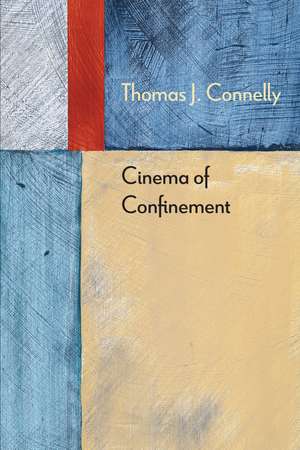Cinema of Confinement: Diaeresis
Autor Thomas J. Connellyen Limba Engleză Paperback – 14 feb 2019
In this book, Thomas J. Connelly draws on a number of key psychoanalytic concepts from the works of Jacques Lacan, Slavoj Žižek, Joan Copjec, Michel Chion, and Todd McGowan to identify and describe a genre of cinema characterized by spatial confinement. Examining classic films such as Alfred Hitchcock's Rope and Stanley Kubrick's The Shining, as well as current films such as Room, Green Room, and 10 Cloverfield Lane, Connelly shows that the source of enjoyment of confined spaces lies in the viewer's relationship to excess.
Cinema of Confinement offers rich insights into the appeal of constricted filmic spaces at a time when one can easily traverse spatial boundaries within the virtual reality of cyberspace.
Cinema of Confinement offers rich insights into the appeal of constricted filmic spaces at a time when one can easily traverse spatial boundaries within the virtual reality of cyberspace.
Preț: 346.27 lei
Nou
Puncte Express: 519
Preț estimativ în valută:
66.27€ • 71.96$ • 55.66£
66.27€ • 71.96$ • 55.66£
Carte indisponibilă temporar
Doresc să fiu notificat când acest titlu va fi disponibil:
Se trimite...
Preluare comenzi: 021 569.72.76
Specificații
ISBN-13: 9780810139213
ISBN-10: 0810139219
Pagini: 184
Ilustrații: 13 b-w images
Dimensiuni: 152 x 229 x 15 mm
Greutate: 0.22 kg
Editura: Northwestern University Press
Colecția Northwestern University Press
Seria Diaeresis
ISBN-10: 0810139219
Pagini: 184
Ilustrații: 13 b-w images
Dimensiuni: 152 x 229 x 15 mm
Greutate: 0.22 kg
Editura: Northwestern University Press
Colecția Northwestern University Press
Seria Diaeresis
Notă biografică
THOMAS J. CONNELLY is a visiting assistant professor in the Media Studies Department at Pomona College.
Recenzii
“In looking at film from a Lacanian angle, Cinema of Confinement makes a strong contribution to the expanding critical literature on Lacan and cinema. The book shows exceptional knowledge of film as a language, inclusive of its unconscious underpinnings. The author moves very confidently among different filmic genres and aesthetic registers, demonstrating remarkable analytical skills. A great book with some interpretive gems.” —Fabio Vighi, author of Critical Theory and Film: Rethinking Ideology through Film Noir
"Connelly’s Cinema of Confinement, far from being a confining read is a wonderful exposition of how cinema’s articulation of psychic and physical spaces and temporalities engage our pleasure and anguish. Through a number of contemporary and classic films Connelly provokes the reader to consider cinema as affective, surprising and rich in shifting parameters. His architecture of film-space propels us towards entering into a film rather than just watching it. Here Connelly takes up the psychoanalytic project of Žižek, McGowan and Copjec, to remind us through nuanced and sharp critical insights, that cinema’s language of space provides for the ongoing pleasure of subjective reconnaissance." —Cindy Zeiher, School of Language, Social and Political Sciences, University of Canterbury, New Zealand
“Connelly’s Cinema of Confinement provides an enjoyable and detailed analysis of films taking place in a single location, and tensions arising from excesses of the gaze, where spatial limits are imposed upon our desire. Using cinema to explain the relationship between space and lack, Connelly provides an important theoretical model for more broadly interpreting the spatial limits of desire in our new media environments.” —Matthew Flisfeder, University of Winnipeg
"Thomas J. Connelly creatively and lucidly investigates a genre of cinema he terms 'the cinema of confinement.' Defining his term by referring to David Fincher’s Panic Room (2002) as a film where 'the narrative tension focuses predominantly within one location,' he highlights a wealth of films characterised by their minimal range of settings and limited spatial parameters within these settings . . . He leaves the reader with the conclusion that confinement cinema has a powerful effect on the spectator given how it enforces spatial limitations, speaking to our particular technological moment and, without a doubt, making 'for a suspenseful and energizing spectatorship.'" —Cassice Last, Frames Cinema Journal
"Thomas J. Connelly creatively and lucidly investigates a genre of cinema he terms 'the cinema of confinement.' Defining his term by referring to David Fincher’s Panic Room (2002) as a film where 'the narrative tension focuses predominantly within one location,' he highlights a wealth of films characterised by their minimal range of settings and limited spatial parameters within these settings . . . He leaves the reader with the conclusion that confinement cinema has a powerful effect on the spectator given how it enforces spatial limitations, speaking to our particular technological moment and, without a doubt, making 'for a suspenseful and energizing spectatorship.'" —Cassice Last, Frames Cinema Journal
Descriere
Drawing on Lacan's notion of the gaze, Cinema of Confinement argues that the transformation of space within confined locations in cinema is a result of how the filmmaker articulates and visualizes the excess of the image.











